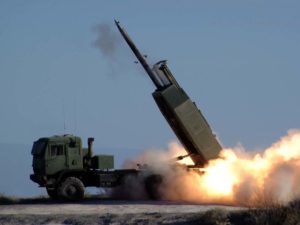The U.S. has approved a new $1.1 billion weapons aid package for Ukraine, which includes plans to eventually provide Kyiv with 18 more High Mobility Artillery Rocket Systems (HIMARS) launchers.
The latest security assistance deal, which includes capabilities to be procured from industry using Ukraine Security Assistance Initiative (USAI) funds, will more than double the number of HIMARS the U.S. has previously provided to Ukraine.

“This USAI package underscores the U.S. commitment to continuing to support Ukraine over the long term. It represents a multi-year investment in critical capabilities to build the enduring strength of Ukraine’s Armed Forces as it continues to defend Ukraine’s sovereignty and territory in the face of Russian aggression,” the Pentagon wrote in a statement on Wednesday.
As opposed to equipment pulled from existing DoD inventories by presidential drawdown authority, USAI is used to buy capabilities directly from industry which will be supplied to Ukraine to meet mid-term and enduring security requirements.
Along with the 18 HIMARS launchers, the new $1.1 billion USAI package also includes 150 armored Humvees, 150 tactical vehicles to tow weapons and 40 trucks and 80 trailers for transporting heavy equipment.
The new security assistance deal also includes two radars for unmanned aerial systems, 20 multi-mission radars, counter-drone systems, tactical secure communications equipment, surveillance systems, explosive ordnance disposal equipment and body armor, according to the Pentagon.
The $3 billion USAI weapons aid package the U.S. approved in late August included capabilities to address Ukraine’s mid to long-term security requirements, with capabilities to be delivered over a course of several months to years (Defense Daily, Aug. 24).
The Pentagon noted the latest package will also include “associated ammunition” for HIMARS, which is likely to be GMLRS rockets as the U.S. has previously provided.
Volodymyr Havrylov, Ukraine’s deputy defense minister, last week reiterated his country’s request for the U.S. to provide longer-range ATACMS missiles for HIMARS (Defense Daily, Sept. 21).
Havrylov said Ukraine’s success using HIMARS to take out Russian logistics and ammunition depots has led Moscow to pull back those posts, out to ranges of 100 kilometers beyond the front lines
“If we have a capability to destroy the targets at depths of 200 kilometers it would be a total disaster for Russia. That’s why we’re asking for ATACMS,” Havrylov said during an address at a National Defense Industrial Association conference in Austin, Texas on Sept. 21. “[With] ATACMS, the U.S. administration still sees it as a threat in case of escalation. They see it as a threat in case we use it against Russian territory. We are arguing that we are not going to use it against Russian territory because we have a lot of targets on our occupied territory, including Crimea.”
ATACMS can reach out to 300 kilometers, more than three times the ability of GMLRS’ max range. Lockheed Martin [LMT] builds the two munitions as well the HIMARS launchers.
“It’s our assessment that the most relevant munitions for the current fight are the GMLRS and so we have prioritized getting the Ukrainians the GMLRS they need not only to hold in the East but to generate some momentum elsewhere in the country. It’s our assessment that they don’t currently require ATACMS to service targets that are directly relevant to the current fight,” Colin Kahl, U.S. under secretary of defense for policy, told reporters in August (Defense Daily, Aug. 24).
Congress is also currently considering stopgap spending legislation to keep the government through Dec. 16, which also includes $12.3 billion in new Ukraine aid supplemental funding (Defense Daily, Sept. 27).
The Ukraine supplemental funding included in the CR covers $3 billion USAI funds where equipment is procured from industry to support Kyiv’s military efforts as well as $3.7 billion in new presidential drawdown authority.
Air Force Brig Gen. Pat Ryder, the Pentagon press secretary, told reporters Tuesday there is about $2.3 billion remaining in current presidential drawdown authority that will expire at the end of September, while reiterating that USAI funds are two-year monies and won’t be affected by the end of the fiscal year.
“I would highlight that it’s not the end of the fiscal year yet, so there’s still time potentially to employ that [presidential drawdown] authorization,” Ryder said during a press briefing.